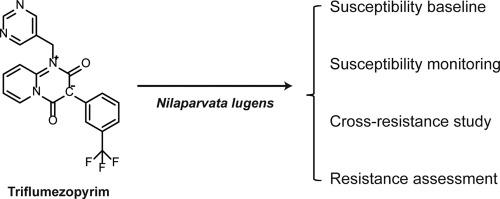当前位置:
X-MOL 学术
›
Pestic. Biochem. Phys.
›
论文详情
Our official English website, www.x-mol.net, welcomes your feedback! (Note: you will need to create a separate account there.)
Baseline determination, susceptibility monitoring and risk assessment to triflumezopyrim in Nilaparvata lugens (Stål)
Pesticide Biochemistry and Physiology ( IF 4.7 ) Pub Date : 2020-05-01 , DOI: 10.1016/j.pestbp.2020.104608 Yan-Chao Zhang 1 , Ze-Rui Feng 1 , Shuai Zhang 1 , Xin-Guo Pei 1 , Bin Zeng 1 , Chen Zheng 1 , Cong-Fen Gao 1 , Xiang-Yang Yu 2
Pesticide Biochemistry and Physiology ( IF 4.7 ) Pub Date : 2020-05-01 , DOI: 10.1016/j.pestbp.2020.104608 Yan-Chao Zhang 1 , Ze-Rui Feng 1 , Shuai Zhang 1 , Xin-Guo Pei 1 , Bin Zeng 1 , Chen Zheng 1 , Cong-Fen Gao 1 , Xiang-Yang Yu 2
Affiliation

|
Triflumezopyrim, a novel mesoionic chemical insecticide, is promoted as a powerful tool for control of susceptible and resistant hopper species in rice throughout Asia. For a newly commercialized insecticide it is important to establish susceptibility baseline, conduct susceptibility monitoring, and assess the risk of resistance via artificial selection to provide foundational information on designing resistance management strategy. The susceptibility baseline of triflumezopyrim was established for three rice planthopper species, Nilarpavata lugens (Stål), Sogatella furcifera (Horváth) and Laodelphax striatellus (Fallén). The LD50 of triflumezopyrim was 0.026, 0.032 and 0.094 ng/individual for the adults of the susceptible strains of S. furcifera, L. striatellus and N. lugens, respectively, determined by a topical application method. Using a rice stem (seedling) dipping method, the LC50 was determined as 0.042, 0.024 and 0.150 mg/L for the nymphs (3rd instar) of the three hopper species, respectively. In the meanwhile, the LC50 of Pyraxalt™ (triflumezopyrim 10% SC) was 0.064 mg/L for the N. lugens susceptible strain. Furthermore, the susceptibility of triflumezopyrim and other five neonicotinoid insecticides were monitored for N. lugens field populations collected from major rice production areas in China in 2015-2019. All monitored populations were susceptible to triflumezopyrim (0.5 to 3.9-fold resistance ratio), and showed no cross-resistance to the other five neonicotinoids. These results suggested that triflumezopyrim is a good option to control resistant N. lugens. In addition, a field-collected population of N. lugens was artificially selected with triflumezopyrim for 20 generations and resulted in 3.5-fold increase in LC50 from F0 and 6.0-fold increase from that of the susceptible strain. The realized heritability (h2) of resistance was estimated as 0.0451 by using threshold trait analysis. With this h2 value, the projected triflumezopyrim resistance development (a 10-fold increase in LC50) would be expected after 30.3 or 24.0 generations if 80% or 90% of the population was killed at each generation.
更新日期:2020-05-01



























 京公网安备 11010802027423号
京公网安备 11010802027423号